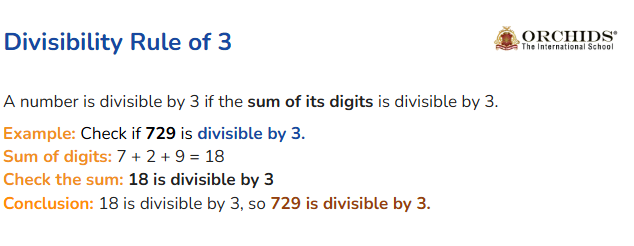Divisibility Rule of 3: Rule, Examples
Divisibility Rule of 3
A number is divisible by 3 if the sum of its digits is a multiple of 3 (like 3, 6, 9, 12, 15, etc.).
If the sum is divisible by 3, then the whole number is also divisible by 3.
Steps to Check Divisibility by 3
-
Write down the number.
-
Add up all the digits.
-
Check if the sum is a multiple of 3.
-
If yes, the number is divisible by 3.
Examples
Example 1: Is 273 divisible by 3?
-
Number: 273
-
Add the digits: 2 + 7 + 3 = 12
-
12 is a multiple of 3 (12 ÷ 3 = 4)
273 is divisible by 3.
Example 2: Is 458 divisible by 3?
-
Number: 458
-
Add the digits: 4 + 5 + 8 = 17
-
17 is not a multiple of 3.
458 is not divisible by 3.
Know the divisibility rule of 4 here.
Try It Yourself:
Are they divisible by 3?
1. 792
2. 145
3. 906
FAQs
-
What is the divisibility rule of 3 with example?
Divisibility rule for 3 states that a number is completely divisible by 3 if the sum of its digits is divisible by 3. Consider a number, 308. To check whether 308 is divisible by 3 or not, take the sum of the digits (i.e. 3+0+8= 11).
-
Is 129857 divisible by 3?
Since 32 is not divisible by 3, so using the divisibility test for 3, we conclude that 129857 is not divisible by 3.
-
What is an example of a divisible by 3?
Numbers that are divisible by 3 can be split into equal parts of 3 with no remainder, like 12 in the earlier example. Other numbers divisible by 3 include 9, 15, 18, 21, and so on.
CBSE Schools In Popular Cities
- CBSE Schools in Bangalore
- CBSE Schools in Mumbai
- CBSE Schools in Pune
- CBSE Schools in Hyderabad
- CBSE Schools in Chennai
- CBSE Schools in Gurgaon
- CBSE Schools in Kolkata
- CBSE Schools in Indore
- CBSE Schools in Sonipat
- CBSE Schools in Delhi
- CBSE Schools in Rohtak
- CBSE Schools in Bhopal
- CBSE Schools in Aurangabad
- CBSE Schools in Jabalpur
- CBSE Schools in Jaipur
- CBSE Schools in Jodhpur
- CBSE Schools in Nagpur
- CBSE Schools in Ahmednagar
- CBSE School In Tumkur












